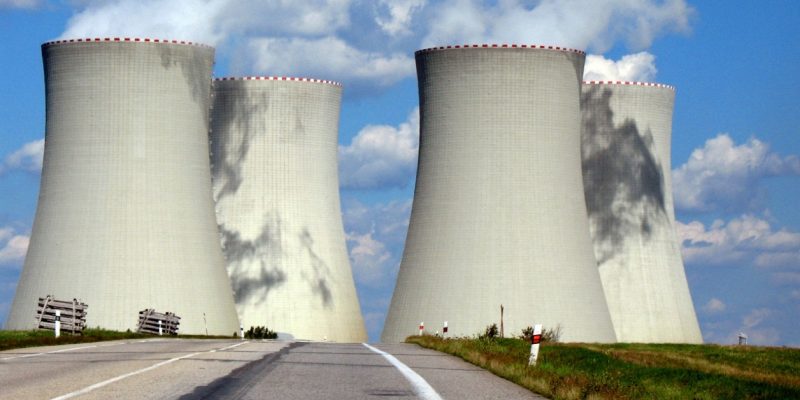
सीएसआईआर-एम्प्री, एक्स-रे डायग्नोस्टिक सेंटर से लेकर परमाणु ऊर्जा संयंत्रों तक विभिन्न क्षेत्रों में उपयोग के साथ एक्स-रे, गामा और न्यूट्रॉन विकिरण से बचाव के लिए सामग्री विकसित करने पर काम कर रहा है। इस कार्य में समर्पित वैज्ञानिकों और तकनीकी कर्मचारियों, सहायक कर्मचारियों और एसीएसआईआर छात्रों के साथ का समूह भौतिकी, रसायन विज्ञान, रसायन इंजीनियरिंग और सिविल इंजीनियरिंग जैसे मजबूत बहु-विषयक टीम बनाता अपना सहयोग प्रदान करते हैं| उन्नत परिरक्षण चरणों को बनाने के लिए अद्वितीय जियो-पॉलीमराइजेशन प्रसंस्करण का उपयोग करके और अच्छी यांत्रिक शक्ति के साथ सामग्री को फ्लाई-ऐश, रेड मड और अन्य औद्योगिक कचरे इत्यादि से बनाया जाता है। विभाग में चल रही कुछ परियोजनाओं का वर्णन नीचे दिया गया है:
सीमेंट मुक्त प्राकृतिक कंक्रीट बनाने के लिए उपयोगी फ्लाई ऐश आधारित उन्नत लिग्नो -सिलिको-एल्युमिनियस (एलएसए) जियोपॉलीमेरिक बाइंडर का विकास:
अनुसंधान एवं विकास परियोजना सारांश:
- लिग्नो सिलिको (एलएस) क्षारीय उत्प्रेरक को कृषि अपशिष्ट जैसे चावल की भूसी और क्षारीय रसायन का उपयोग करके विकसित किया गया है।
- विकसित एलएस एल्कलाइन एक्टिवेटर का उपयोग लिग्नो-सिलिको-एल्युमिनियस (एलएसए) आधारित जियोपॉलिमर कंक्रीट की तैयारी के लिए किया गया था, जिसके लिए एलएस एल्कलाइन एक्टिवेटर/फ्लाई ऐश के अनुपात को अलग-अलग करके विभिन्न मिश्रण डिजाइन विकसित किए गए थे। सभी क्यूब्स को 48 घंटे के लिए 60 डिग्री सेल्सियस पर थर्मल रूप से ठोस किया गया और 28 दिनों के बाद 0.47 अनुपात पर अधिकतम संपीड़न शक्ति 30.8 एमपीए प्राप्त हुई।
- इस कंक्रीट को विभिन्न ग्रेड के विकास के लिए विकसित किया गया था और परिणामस्वरूप एलएस अल्कलाइन एक्टिवेटर की मोलरिटी को बदलकर एलएस सॉल्यूशन एम 15, एम 20 और एम 25 का उपयोग करके कंक्रीट के विभिन्न ग्रेड विकसित किए गए थे। एलएसए जियोपॉलिमर कंक्रीट को परिवेश और थर्मल ठीक स्थितियों दोनों के लिए विकसित किया गया था और अनुकूलित संरचना के लिए फ्लेक्सुरल बीम को 28 दिनों में डाला और परीक्षण किया गया, जिसके परिणामस्वरूप 8.75, 25 और 12.5 मोलर एलएस समाधान पर 3.4MPa, 4.5MPa और 5.2MPa की फ्लेक्सुरल शक्ति प्राप्त हुई।
- क्यूब्स और बीम को 48 घंटे की इलाज अवधि के लिए अनुकूलित एलएस क्षारीय एक्टिवेटर का उपयोग करके 30 से 150 डिग्री सेल्सियस तक के विभिन्न तापमान पर डाला गया और अधिकतम संपीड़न शक्ति 120 डिग्री सेल्सियस यानी 46.3 एमपीए पर प्राप्त की गई थी और फ्लेक्सुरल अधिकतम शक्ति 28 दिन और 120 डिग्री सेल्सियस पर 7.75 एमपीए प्राप्त की गई ।
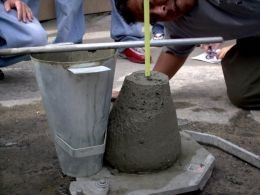
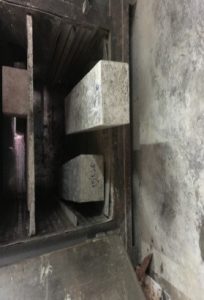
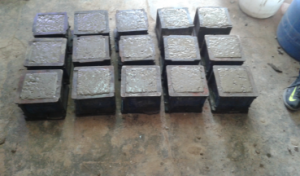
Evaluation of engineering properties of Ligno-Silico-Aluminious (LSA) based Geopolymer Concrete
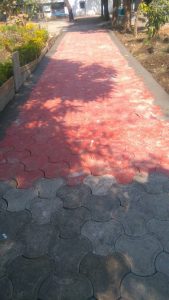
(चित्र ) सीएसआईआर-एएमपीआरआई में कार्यशाला के सामने उन्नत एलएसए आधारित जियोपॉलिमर कंक्रीट पेवर ब्लॉक का प्रदर्शन
उन्नत लिग्नो-सिलिको-एल्युमिनियस (एलएसए) जियोपॉलीमेरिक सामग्री बनाने के लिए लाल मिट्टी का बहुतायत में उपयोग:
रेड मड एक ठोस अपशिष्ट है जो बायर प्रक्रिया के बाद बॉक्साइट से एल्यूमिना उत्पादन की प्रक्रिया में उत्पन्न होता है। संसाधित कच्चे माल के आधार पर उत्पादित प्रत्येक टन एल्यूमिना के लिए 1.0 – 2.5 टन रेड मड उत्पन्न होती है। केवल भारत में ही प्रतिवर्ष 5 मिलियन टन से अधिक लाल मिट्टी उत्पन्न होती है। वर्तमान में, इसे एल्यूमिना रिफाइनरियों के पास जमीन पर डंप किया जाता है। इसकी उच्च क्षारीयता पानी के लिए संभावित प्रदूषण का खतरा है, और अवशेषों के भंडारण के लिए आवश्यक भूमि के बड़े क्षेत्र के साथ उच्च लागत जुड़ी हुई है। भारत दुनिया में एल्युमिना के प्रमुख उत्पादकों में से एक है। पिछले दशक में भारत में रेड मड के उपचार और उपयोग में महत्वपूर्ण उपलब्धियाँ हासिल की गई हैं। अब भारत में रेड मड के बड़े पैमाने पर उपयोग की तत्काल आवश्यकता है।
सीएसआईआर-एम्प्री, भोपाल ने जियोपॉलीमेरिक स्पेक्ट्रम दृष्टिकोण के रूप में व्यापक क्षमता के माध्यम से रेडमड और फ्लाई ऐश की विशाल उपलब्धता का उपयोग करके परियोजना गतिविधि को पूरा करने का प्रस्ताव दिया। इसका उपयोग रेडमड-फ्लाई ऐश आधारित उन्नत लिग्नो-सिलिको-एल्यूमीनियम (एलएसए) जियोपॉलीमेरिक बाइंडर के विकास में किया जाना प्रस्तावित था । हमारे काम का उद्देश्य फ्लाई ऐश का उपयोग करके रेडमड पर आधारित निर्माण सामग्री के विकास में जियोपॉलीमराइजेशन प्रक्रिया के उपयोग को सक्षम करने वाली सबसे अनुकूल परिस्थितियों को परिभाषित करना है। परिणामों के आधार पर विकसित एलएसए जियोपॉलीमेरिक सामग्रियों के संतोषजनक यांत्रिक और अन्य गुणों के संबंध में जियोपॉलीमराइजेशन के लिए इष्टतम स्थितियां और मुख्य संश्लेषण मापदंडों का प्रभाव निर्धारित किया गया । फ्लाई ऐश का उपयोग करके रेडमड के जियोपॉलीमराइजेशन द्वारा उत्पादित विकसित अकार्बनिक पॉलिमर सामग्री संतोषजनक संपीड़न शक्ति विकसित करेगी जिससे निर्माण उद्योग के लिए इन सामग्रियों का उपयोग किया जा सकेगा। यह दो औद्योगिक कचरे अर्थात् रेडमड और फ्लाई ऐश का अधिकतम उपयोग सुनिश्चित करेगा।
अखिल भारतीय आयुर्विज्ञान संस्थान (एम्स) में उन्नत (सीमेंट मुक्त) ठोस रूप जियोपॉलीमर बाइंडर आधारित कंक्रीट फुटपाथ रोड
23 x 3.5 x 0.11 मीटर आयाम की एक सीमेंट मुक्त फुटपाथ गुणवत्ता वाली ग्रीन कंक्रीट सड़क का निर्माण एम्स भोपाल में डेमोस्ट्रेशन के लिए किया गया था। निम्नलिखित इंजीनियरिंग गुण यानी घनत्व: 2400 – 2600 किलोग्राम/घन मीटर, संपीड़न शक्ति: 35 एमपीए, लचीली ताकत: 4.0 एमपीए, मंदी: 110-120 मिमी। सड़क के निर्माण में चार टन फ्लाई ऐश और 8.85 घन मीटर सीमेंट मुक्त कंक्रीट का उपयोग किया गया। एक सप्ताह के बाद सड़क उपयोग के लिए तैयार थी।
पारंपरिक सीमेंट कंक्रीट सड़क की तुलना में लाभ:
- इस सड़क के लिए औद्योगिक कचरे का उपयोग किया गया
- जल उपचार की आवश्यकता समाप्त हो जाती है
- एक सप्ताह के भीतर सड़क “उपयोग के लिए तैयार” हो जाती है |
 |
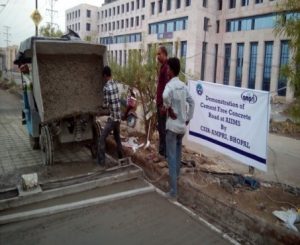 |
 |
Demonstration of Cement Free Geopolymer Concrete at AIIMS Bhopal
कंक्रीट संरचनाओं में उपयोग किए जाने वाले हल्के स्टील रीन्फोर्स्मेंट के क्षरण से सुरक्षा के लिए उन्नत जियोपॉलीमेरिक कोटिंग सामग्री के विकास पर अनुसंधान एवं विकास अध्ययन
माइल्ड स्टील (MS) का उपयोग पूरी दुनिया में पाइप, तार, समुद्री अनुप्रयोगों, परमाणु संचालित परिवहन, सुदृढीकरण, बाड़ लगाने, धातु-प्रसंस्करण उपकरण आदि में संरचनात्मक स्टील के रूप में किया जाता है। यह प्रतिकूल पर्यावरणीय परिस्थितियों के अधीन है जो जंग का कारण बनता है और परिणामस्वरूप हल्के स्टील आधारित संरचनाओं के जीवनकाल में कमी आती है। इस समस्या का समाधान करने के लिए, संक्षारण प्रतिरोध और मूल सतह पर आसंजन/चिपकाव के बेहतर गुणों के साथ उन्नत कोटिंग सामग्री के विकास के लिए दुनिया भर में अनुसंधान प्रगति पर है। जियोपॉलिमर, जो अर्ध क्रिस्टलीय एलुमिनो सिलिकेट सामग्री के लिए क्षार सक्रिय अनाकार हैं, का हाल के वर्षों में कोटिंग सामग्री के रूप में व्यापक रूप से अध्ययन किया गया है। वर्तमान कार्य में, नई प्रक्रिया द्वारा फ्लाई ऐश, रेडमड, मेटाकाओलिन, फॉस्फेट और अन्य एडिटिव्स का उपयोग करके फॉस्फेटिक जियोपॉलीमेरिक कोटिंग सामग्री की विभिन्न संरचनाएं विकसित की गईं और डिप, स्प्रे और पेंट ब्रश कोटिंग तकनीकों द्वारा हल्के स्टील प्लेटों पर लेपित किया गया। लेपित हल्के स्टील प्लेटों का आसंजन शक्ति, उच्च तापमान प्रतिरोध, अग्नि प्रतिरोध और जल प्रतिरोध और संक्षारण प्रतिरोध गुणों के लिए परीक्षण किया गया। लेपित हल्के स्टील प्लेटों ने 3.5 एमपीए तक आसंजन शक्ति का संकेत दिया और कोटिंग 500 डिग्री सेल्सियस तक स्थिर पाई गई। विकसित कोटिंग सामग्री रचनाओं का 3.5% NaCl का उपयोग करके वजन घटाने की विधि द्वारा संक्षारण प्रतिरोध गुणों के लिए परीक्षण किया गया था। लेपित मिल स्टील प्लेटों की संक्षारण सुरक्षा दक्षता 80 से 85% पाई गई और संक्षारण दर अनकोटेड माइल्ड स्टील की तुलना में 2-3 गुना कम है। एनोडिक ध्रुवीकरण विधि का उपयोग करके संक्षारण प्रतिरोध के परीक्षण के लिए विद्युत रासायनिक माप किए गए। जियोपॉलीमर लेपित हल्के स्टील प्लेटों के माध्यम से धारा का प्रवाह का छोटा सा मार्ग संक्षारण के प्रति लेपित सामग्रियों के मजबूत प्रतिरोध की पुष्टि करता है। नमक स्प्रे कक्ष में त्वरित संक्षारण परीक्षण किया गया। 20-22 घंटों के बाद शुरू होने वाले संक्षारण की शुरुआत फिर से संक्षारण के प्रति लेपित सामग्रियों के मजबूत प्रतिरोध की पुष्टि करती है।
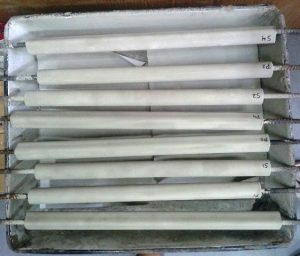
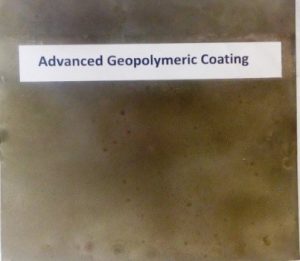
Geopolymer coated mild steel tubes and Plate
कोटिंग रचनाओं के एक्स-रे विवर्तन पैटर्न ने सोडियम सिलिकेट और हाइड्रेटेड सोडियम एल्यूमीनियम सिलिकेट जैसे जियोपॉलीमेरिक चरणों की उपस्थिति का संकेत दिया। एसईएम छवियों ने सतह पर कोटिंग सामग्री (माइल्ड स्टील) के मजबूत बंधन का संकेत दिया। परिणामों से पता चला कि विकसित कोटिंग सामग्री में आशाजनक संक्षारण प्रतिरोध विशेषताएं हैं। बेहतर आसंजन शक्ति और संक्षारण संरक्षण विशेषताओं के साथ नवीन कोटिंग सामग्री रचनाओं के विकास पर आगे के अध्ययन प्रगति पर हैं।
फ्लाईएश/तालाब फ्लाईएश को फाइन एग्रीगेट में बदलने पर व्यवहार्यता अध्ययन और प्रक्रिया विकास:
- रासायनिक प्रतिक्रिया तंत्र (समय और तापमान में भिन्नता)
- सामग्रियों की भूमिका (घटकों और एकाग्रता में भिन्नता)
- विकसित सामग्री का निस्र्पण (करेक्टराईजेशन )
- जियोपॉलीमेरिक रेत और पारंपरिक रेत (भारतीय मानक के अनुसार रासायनिक और सिविल इंजीनियरिंग गुण) के बीच तुलनात्मक अध्ययन
- मापदंडों का अनुकूलन. पोंड ऐश/फ्लाई ऐश से प्राप्त सिंथेटिक रेत के साथ नदी की रेत का पूर्ण/आंशिक प्रतिस्थापन।
प्रत्याशित लाभ: अध्ययन से प्राकृतिक रेत की मांग, फ्लाई ऐश से संबंधित पर्यावरणीय समस्याओं, लैंडफिल क्षेत्र की आवश्यकता को कम करने और ऊर्जा संरक्षण में योगदान करने में मदद मिलेगी। इस कार्य का उद्देश्य लाभकारी तरीके से फ्लाई ऐश उपयोग दर को अधिकतम सीमा तक बढ़ाने पर ध्यान केंद्रित करना है।
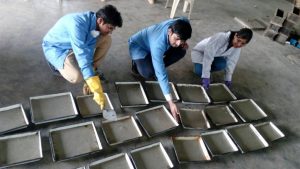

Fine aggregates (sand sized) prepared by fly ash
